Stargazing

|
Up the Milky Way |

|
- Note - we might have this discussion any time during
the sky tour, whenever it comes up.
You can see the Milky Way on any clear summer night, but up in the north woods, on especially clear nights, the Milky Way glows like a neon light, from north horizon to south horizon, brilliantly reflected in the lake by our camp. Most people recognize the Milky Way as a band of light across the night sky, but what is that band of light - where does it come from?
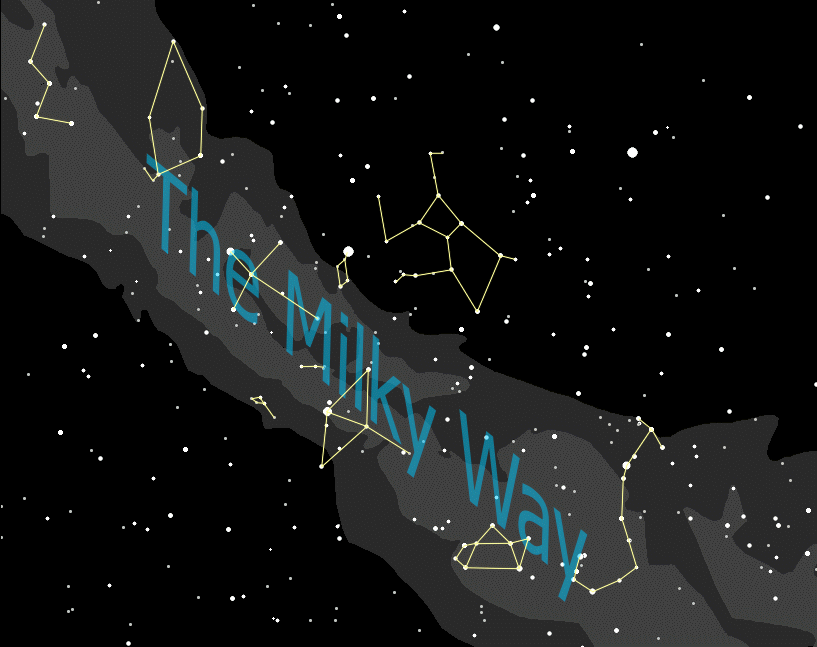
- Well it's a bit like looking at a gravel road. Close to you, you can see
individual stones, while off in the distance the road merges into a uniform
gray. When you look at the Milky Way you are looking at the disk of our
galaxy from the inside - the nearby stars you can see individually (most
are less than 1,000 light years away), the distant stars merge into a hazy
glow. So when you see that band across the sky you are really looking way
off into the distance, into the "billions and billions" of stars that make
up the disk of our galaxy.

You'll see a similar phenomenon later when you look at the M13 globular cluster in Hercules. Through binoculars you will see it as a hazy patch. When you see it through a telescope - that is, closer up - you can pick out individual stars. The better the telescope, the 'closer' you can get to M13, the more stars you can see.
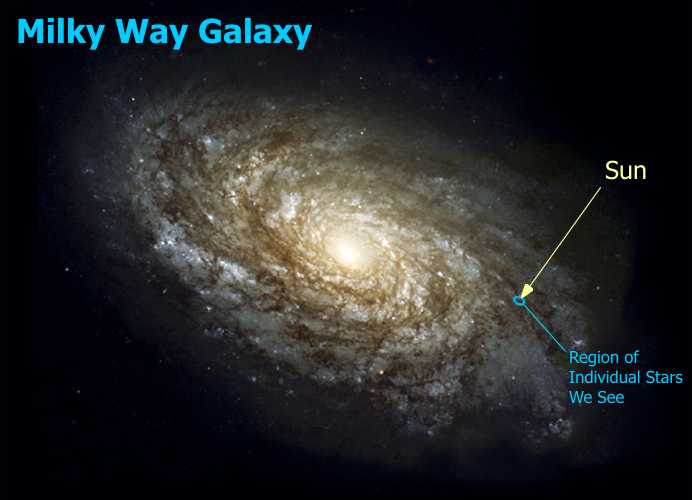
- We can find some more constellations -- some of the best --
by following the Milky Way up from Scorpius and Sagittarius. First we come
to Aquila the Eagle. {Trace out Aquila.} The bright star is Altair, and
the two stars on either side of Altair are called the Pilot Stars. Altair
is 16 light years away. It's about half again as big as our sun and nine
times as bright. That shows how sensitive stars are to mass -- just a
little more mass causes the star to burn much brighter.
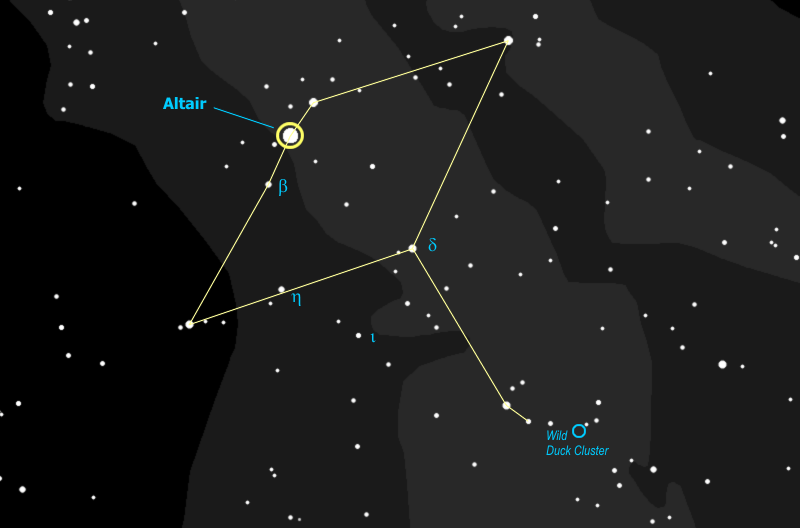
The star that is about halfway between Aquila's eastern wingtip and his body is called η (Eta) Aquilae -- and this is another Cepheid variable with a cycle of about 7 days. At its brightest it's nearly as bright as the body star, δ (Delta) Aquilae (actually it's as bright as the eastern Pilot Star β Aquilae), and at its dimmest it's about as bright as ι (Iota) Aquilae. This is one of only three Cepheids you can see by eye - you already met δ Cephei, the original, and the third one is in the winter constellation of Gemini.
- If you look with the binoculars you can find the two stars of Aquila's tail,
then slide west (to the right) until they are at the far left of the field
of view. To the far right of your field of view you can now see a fuzzy
spot with a star at the center - you have found the Wild Duck Cluster. In
a telescope this looks like a dense cluster of tiny stars broken into groups -
the central group is V-shaped and looked to early observers like a flight of
wild ducks - hence the name.
- The next constellation we reach is Cygnus the Swan.
{Trace out Cygnus}. This constellation is also known as the Northern
Cross and at Christmas time, in the evening, it has rotated across the sky
so it is standing on its base on the northwestern horizon, with the bright
star Vega next to it. Very Christmas-y.
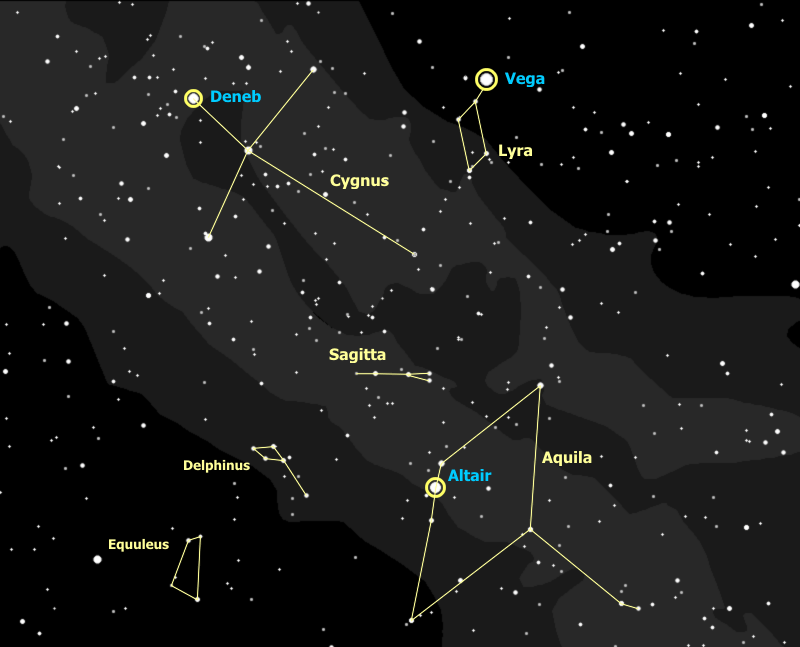
Deneb is the star at the tail of the Swan. Notice that it is about as bright as Altair, which is 16 light years away -- so how far would you guess Deneb is? As it happens... Deneb is 2600 light years away - about 150 times farther!! Deneb is actually 20,000 times brighter than Altair and 200,000 times brighter than our sun. If Deneb were as close as Altair, it would be visible in broad daylight and would cast a shadow at night. This star is one of the greatest super-giant stars known.
Notice in the picture above that Altair and Deneb are two of the three bright stars overhead, which form the "Summer Triangle". You will be introduced to the third (Vega) in just a moment.
Albireo, the star at the head of the swan, is actually a beautiful double star, a yellow giant and a blue main-sequence star. You can just split this star with good binoculars held steady, and it looks better in a telescope.
- You can use Cygnus (the Northern Cross) as a gauge of the sky, in similar fashion
to the Little Dipper, but with Cygnus at a higher
elevation, you can check the sky at its very best. Use the western wing of Cygnus,
starting with Deneb as a magnitude 1, and going around counterclockwise to the
body star at magnitude 2, the wingtip at magnitude 3, and a pair of stars on the
back edge of the wing at magnitude 4. Just off the wingtip is a magnitude 5 star
- if you can see it, you have an excellent clear, dark sky. Half-way between the
wingtip and the pair of magnitude 4's is a magnitude 6, which you can only see
under the very best conditions.
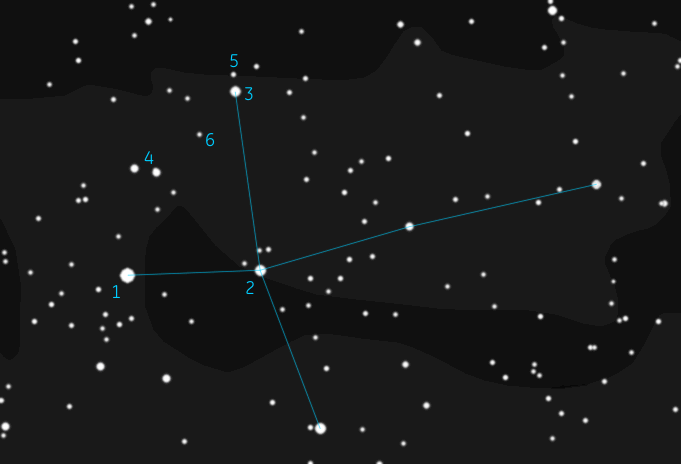
- The Milky Way looks like a single solid band as you follow it from Cassiopeia
through Cygnus to Sagittarius, but this is misleading. When you look at the
"steam" above the spout of the Teapot in Sagittarius, you are looking toward
the center of the galaxy but you are not actually seeing the center of
the galaxy. You are actually looking at the great, massive spiral arm next to
ours, the next one in toward the center. You go through this spiral arm, past
lanes of dust, and through two smaller spiral arms before you finally reach the
center. When you look at Cygnus, you are looking right down the beam of our
local spiral arm, which is really just a tiny branch off the Sagittarius arm.
Then when you look at Cassiopeia, you are looking at the great massive spiral
arm that is just outside ours. Beyond that arm lies one more final wisp, and
beyond that... the rest of the universe.
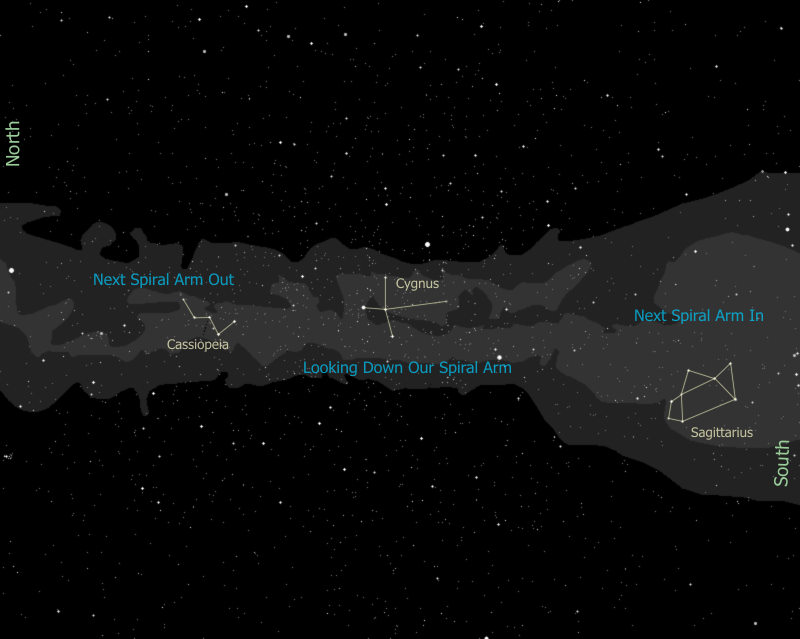
Note that you can see how this all lays out, looking down on the galaxy, in the latest Milky Way diagram to come from NASA, based on new Spitzer Telescope observations.
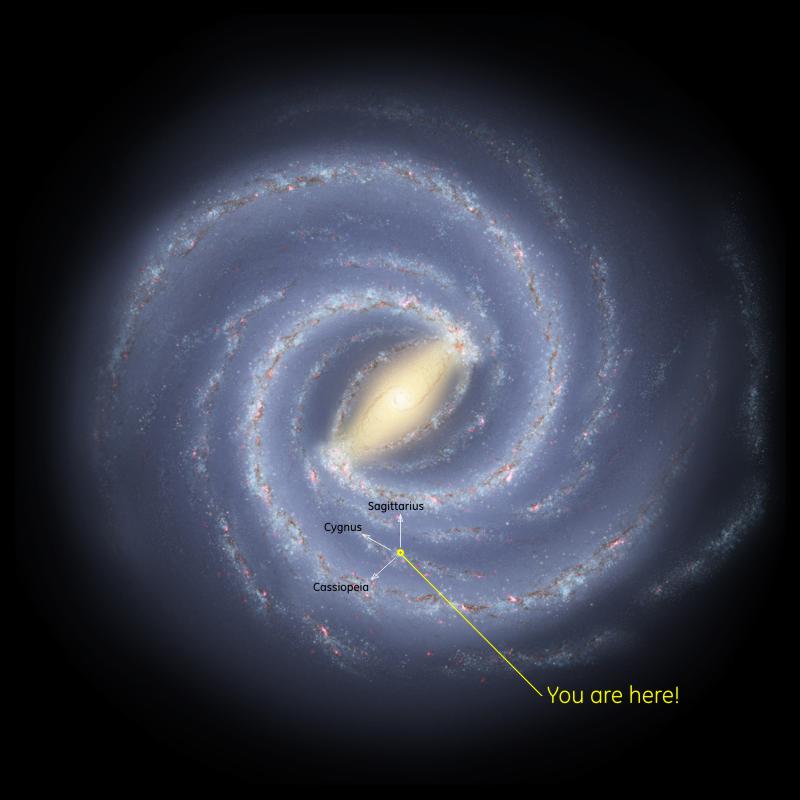
- Just above and to the east of Aquila you can spot a small diamond of stars with a little tail coming down. This is the tiny constellation, Delphinus the Dolphin. It really looks like a little dolphin, doesn't it?
- Then next to Delphinus, continuing to the left (east) is another teeny tiny,
and faint constellation, Equuleus the Horse. It's four stars forming a horse's
head, with the nose pointing up, to the North. See it? Actually it's five
stars, the corner by his jaw is a pair of stars. Equuleus is in competition for
"Smallest Constellation in the Sky" -- only the Southern Cross, next to the South
Pole, is smaller, by just a sliver.
- The two birds, Aquila the Eagle and Cygnus the Swan, are
flying straight at each other and, to enhance the suspense, Sagitta the Arrow
flies between them, just missing both. {Trace out Sagitta.} What is most
interesting about Sagitta, though, is not so much the constellation as the
features for which it is a milestone. (Note: these two features, technically,
are in the neighboring and very faint constellation "Vulpecula" the Fox.)
If you locate the two tail-feather stars of Sagitta in binoculars then follow the line between them up (to the northwest), just one field of view, you will see the Coathanger, an interesting cluster of stars.
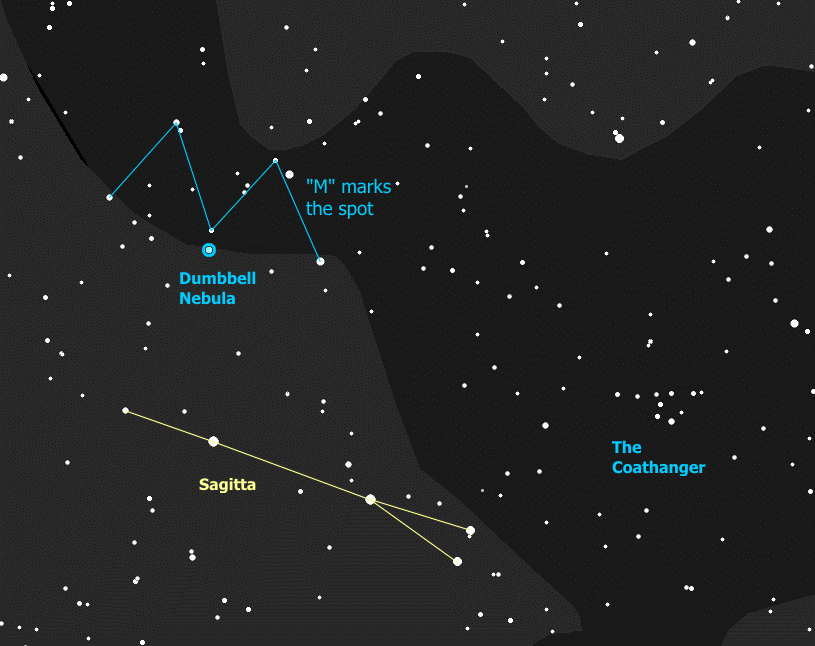
If you are really good with those binoculars you can go up from the tip of the arrow, toward Albireo in Cygnus, and you will find a group of stars that just fill the field of view in the shape of an "M". Right at the central point of the "M" is a faint fuzzy patch that actually is known as the "Dumbbell Nebula". To really see its hourglass shape requires a telescope. This hazy patch once was a star, until it blew itself apart.
This is called a "planetary nebula", because the typical disk shape (this one is less typical) suggested the look of a planet to early astronomers. In fact it has nothing to do with planets at all. This is what's left of a red giant star that finally did what all red giants eventually do. When the fuel at the core runs so low that the nuclear reactions can no longer hold up the weight of the star, it all collapses in to the center, which in turn raises the temperature so high that the star blows off its outer envelope of gases, losing much of its mass. This exposes the core to outer space, or, more accurately, exposes outer space to the core. The intense radiation from the core causes the expanding shell of gas to light up like a neon light, and voila -- the faintly glowing dumbbell that you see here. The white-hot core of this star is now a "white dwarf" -- on some planetaries you can see the star at the center. The Dumbbell's central star is notoriously elusive, though, and we probably can't see it in our telescope.
So diffuse nebulae, like the two we saw in Sagittarius, are the birthplaces of many new stars, and a planetary nebula is the deathbed of a single dying star. We will see another, even more famous, planetary nebula in the next constellation.
 |
 |
 |
| Back to Scorpius | Go to Summer Index | On to Lyra |
Questions
Your questions and comments regarding the Stargazing section are welcome.
You can e-mail the author, Randy Culp for inquiries,
suggestions, new ideas or just to chat.
Updated 18 July 2023
